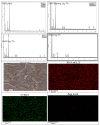Development of Ag-Doped ZnO Thin Films and Thermoluminescence (TLD) Characteristics for Radiation Technology
- PMID: 36080105
- PMCID: PMC9459964
- DOI: 10.3390/nano12173068
Development of Ag-Doped ZnO Thin Films and Thermoluminescence (TLD) Characteristics for Radiation Technology
Abstract
This work examined the thermoluminescence dosimetry characteristics of Ag-doped ZnO thin films. The hydrothermal method was employed to synthesize Ag-doped ZnO thin films with variant molarity of Ag (0, 0.5, 1.0, 3.0, and 5.0 mol%). The structure, morphology, and optical characteristics were investigated using X-ray diffraction (XRD), scanning electron microscope (SEM), energy-dispersive X-ray spectroscopy (EDX), photoluminescence (PL), and UV-vis spectrophotometers. The thermoluminescence characteristics were examined by exposing the samples to X-ray radiation. It was obtained that the highest TL intensity for Ag-doped ZnO thin films appeared to correspond to 0.5 mol% of Ag, when the films were exposed to X-ray radiation. The results further showed that the glow curve has a single peak at 240-325 °C, with its maximum at 270 °C, which corresponded to the heating rate of 5 °C/s. The results of the annealing procedures showed the best TL response was found at 400 °C and 30 min. The dose-response revealed a good linear up to 4 Gy. The proposed sensitivity was 1.8 times higher than the TLD 100 chips. The thermal fading was recorded at 8% for 1 Gy and 20% for 4 Gy in the first hour. After 45 days of irradiation, the signal loss was recorded at 32% and 40% for the cases of 1 Gy and 4 Gy, respectively. The obtained optical fading results confirmed that all samples' stored signals were affected by the exposure to sunlight, which decreased up to 70% after 6 h. This new dosimeter exhibits good properties for radiation measurement, given its overgrowth (in terms of the glow curve) within 30 s (similar to the TLD 100 case), simple annealing procedure, and high sensitivity (two times that of the TLD 100).
Keywords: Ag; ZnO; dosimetry; fading; linear response doses; sensitivity; thermoluminescence.
Conflict of interest statement
The authors declare no conflict of interest.
Figures


















Similar articles
-
Photoluminescence and thermoluminescence dosimetry properties of Ag/Y co-doped ZnO nanophosphor for radiation measurements.Luminescence. 2024 Feb;39(2):e4683. doi: 10.1002/bio.4683. Luminescence. 2024. PMID: 38332469
-
Thermoluminescence dosimeter (TLD) studies of Ca10 K(PO4 )7 :Dy phosphor for applications in radiation dosimetry.Luminescence. 2023 Oct;38(10):1780-1788. doi: 10.1002/bio.4564. Epub 2023 Aug 21. Luminescence. 2023. PMID: 37491134
-
Investigations of thermoluminescence characteristics of CaSiO3:Yb phosphor irradiated with gamma rays and carbon ion beam.Appl Radiat Isot. 2022 Aug;186:110253. doi: 10.1016/j.apradiso.2022.110253. Epub 2022 Apr 25. Appl Radiat Isot. 2022. PMID: 35526336
-
Effect of co-doping of sodium on the thermoluminescence dosimetry properties of copper-doped zinc lithium borate glass system.Appl Radiat Isot. 2016 Dec;118:375-381. doi: 10.1016/j.apradiso.2016.10.005. Epub 2016 Oct 11. Appl Radiat Isot. 2016. PMID: 27894049 Review.
-
An enhancement of photoluminescence property of Ag doped La2O3 thin films at room temperature.Spectrochim Acta A Mol Biomol Spectrosc. 2017 Sep 5;184:71-81. doi: 10.1016/j.saa.2017.04.072. Epub 2017 Apr 28. Spectrochim Acta A Mol Biomol Spectrosc. 2017. PMID: 28486202 Review.
Cited by
-
Synthesis, Characteristics, and Effect of Zinc Oxide and Silver Nanoparticles on the In Vitro Regeneration and Biochemical Profile of Chrysanthemum Adventitious Shoots.Materials (Basel). 2022 Nov 18;15(22):8192. doi: 10.3390/ma15228192. Materials (Basel). 2022. PMID: 36431675 Free PMC article.
-
Cu-doped ZnO/Ag/CuO heterostructure: superior photocatalysis and charge transfer.RSC Adv. 2024 Sep 18;14(41):29763-29773. doi: 10.1039/d4ra05989a. eCollection 2024 Sep 18. RSC Adv. 2024. PMID: 39301231 Free PMC article.
-
Post-Irradiation Behavior of Colored PVA-Based Films Containing Ag Nanoparticles as Radiation Detectors/Exposure Indicators.Gels. 2024 Apr 24;10(5):290. doi: 10.3390/gels10050290. Gels. 2024. PMID: 38786207 Free PMC article.
-
Cu/CuO-Doped ZnO Nanocomposites via Solution Combustion Synthesis for Catalytic 4-Nitrophenol Reduction.ACS Omega. 2023 Mar 2;8(10):9597-9606. doi: 10.1021/acsomega.3c00141. eCollection 2023 Mar 14. ACS Omega. 2023. PMID: 36936329 Free PMC article.
-
Exploring the properties of Dy2O3-Y2O3 Co-activated telluro-borate glass: Structural, physical, optical, thermal, and mechanical properties.Heliyon. 2023 Jul 14;9(7):e18309. doi: 10.1016/j.heliyon.2023.e18309. eCollection 2023 Jul. Heliyon. 2023. PMID: 37539187 Free PMC article.
References
-
- Sinclair S., Pech-Canul M. Development feasibility of TLD phosphors and thermoluminescent composite materials for potential applications in dosimetry: A review. Chem. Eng. J. 2022;443:136522. doi: 10.1016/j.cej.2022.136522. - DOI
-
- Bhatt B.C., Kulkarni M. Defect and Diffusion Forum. Trans Tech Publishing; Geneva, Switzerland: 2014. Thermoluminescent phosphors for radiation dosimetry; pp. 179–227.
-
- Omanwar S., Koparkar K., Virk H.S. Defect and Diffusion Forum. Trans Tech Publishing; Geneva, Switzerland: 2014. Recent advances and opportunities in tld materials: A review; pp. 75–110.
-
- Salah N. Nanocrystalline materials for the dosimetry of heavy charged particles: A review. Radiat. Phys. Chem. 2011;80:1–10. doi: 10.1016/j.radphyschem.2010.08.003. - DOI
Grants and funding
LinkOut - more resources
Full Text Sources

